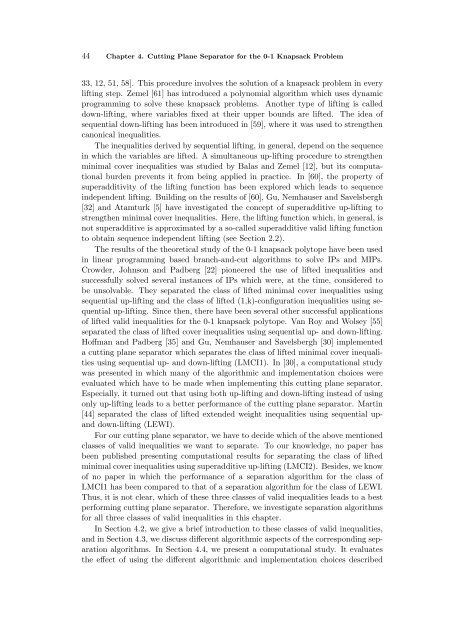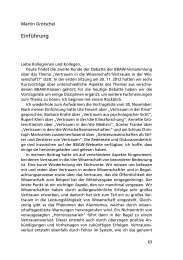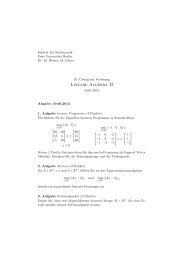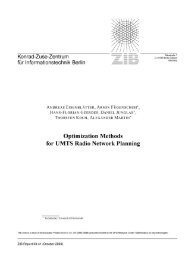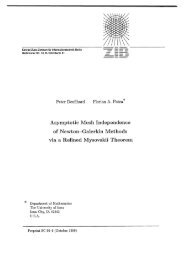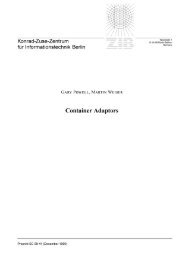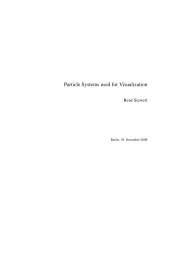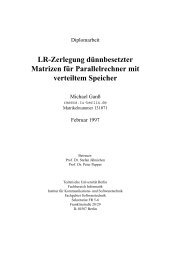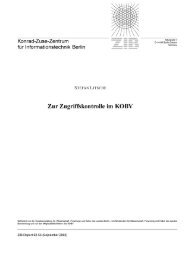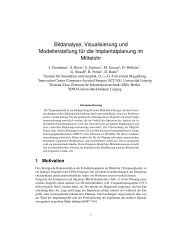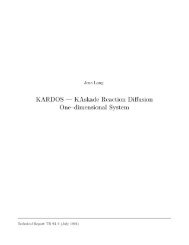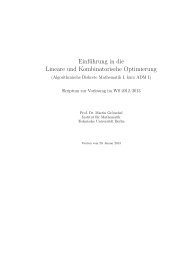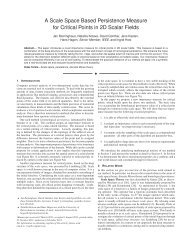Implementation of Cutting Plane Separators for Mixed Integer ... - ZIB
Implementation of Cutting Plane Separators for Mixed Integer ... - ZIB
Implementation of Cutting Plane Separators for Mixed Integer ... - ZIB
Create successful ePaper yourself
Turn your PDF publications into a flip-book with our unique Google optimized e-Paper software.
44 Chapter 4. <strong>Cutting</strong> <strong>Plane</strong> Separator <strong>for</strong> the 0-1 Knapsack Problem<br />
33, 12, 51, 58]. This procedure involves the solution <strong>of</strong> a knapsack problem in every<br />
lifting step. Zemel [61] has introduced a polynomial algorithm which uses dynamic<br />
programming to solve these knapsack problems. Another type <strong>of</strong> lifting is called<br />
down-lifting, where variables fixed at their upper bounds are lifted. The idea <strong>of</strong><br />
sequential down-lifting has been introduced in [59], where it was used to strengthen<br />
canonical inequalities.<br />
The inequalities derived by sequential lifting, in general, depend on the sequence<br />
in which the variables are lifted. A simultaneous up-lifting procedure to strengthen<br />
minimal cover inequalities was studied by Balas and Zemel [12], but its computational<br />
burden prevents it from being applied in practice. In [60], the property <strong>of</strong><br />
superadditivity <strong>of</strong> the lifting function has been explored which leads to sequence<br />
independent lifting. Building on the results <strong>of</strong> [60], Gu, Nemhauser and Savelsbergh<br />
[32] and Atamturk [5] have investigated the concept <strong>of</strong> superadditive up-lifting to<br />
strengthen minimal cover inequalities. Here, the lifting function which, in general, is<br />
not superadditive is approximated by a so-called superadditive valid lifting function<br />
to obtain sequence independent lifting (see Section 2.2).<br />
The results <strong>of</strong> the theoretical study <strong>of</strong> the 0-1 knapsack polytope have been used<br />
in linear programming based branch-and-cut algorithms to solve IPs and MIPs.<br />
Crowder, Johnson and Padberg [22] pioneered the use <strong>of</strong> lifted inequalities and<br />
successfully solved several instances <strong>of</strong> IPs which were, at the time, considered to<br />
be unsolvable. They separated the class <strong>of</strong> lifted minimal cover inequalities using<br />
sequential up-lifting and the class <strong>of</strong> lifted (1,k)-configuration inequalities using sequential<br />
up-lifting. Since then, there have been several other successful applications<br />
<strong>of</strong> lifted valid inequalities <strong>for</strong> the 0-1 knapsack polytope. Van Roy and Wolsey [55]<br />
separated the class <strong>of</strong> lifted cover inequalities using sequential up- and down-lifting.<br />
H<strong>of</strong>fman and Padberg [35] and Gu, Nemhauser and Savelsbergh [30] implemented<br />
a cutting plane separator which separates the class <strong>of</strong> lifted minimal cover inequalities<br />
using sequential up- and down-lifting (LMCI1). In [30], a computational study<br />
was presented in which many <strong>of</strong> the algorithmic and implementation choices were<br />
evaluated which have to be made when implementing this cutting plane separator.<br />
Especially, it turned out that using both up-lifting and down-lifting instead <strong>of</strong> using<br />
only up-lifting leads to a better per<strong>for</strong>mance <strong>of</strong> the cutting plane separator. Martin<br />
[44] separated the class <strong>of</strong> lifted extended weight inequalities using sequential upand<br />
down-lifting (LEWI).<br />
For our cutting plane separator, we have to decide which <strong>of</strong> the above mentioned<br />
classes <strong>of</strong> valid inequalities we want to separate. To our knowledge, no paper has<br />
been published presenting computational results <strong>for</strong> separating the class <strong>of</strong> lifted<br />
minimal cover inequalities using superadditive up-lifting (LMCI2). Besides, we know<br />
<strong>of</strong> no paper in which the per<strong>for</strong>mance <strong>of</strong> a separation algorithm <strong>for</strong> the class <strong>of</strong><br />
LMCI1 has been compared to that <strong>of</strong> a separation algorithm <strong>for</strong> the class <strong>of</strong> LEWI.<br />
Thus, it is not clear, which <strong>of</strong> these three classes <strong>of</strong> valid inequalities leads to a best<br />
per<strong>for</strong>ming cutting plane separator. There<strong>for</strong>e, we investigate separation algorithms<br />
<strong>for</strong> all three classes <strong>of</strong> valid inequalities in this chapter.<br />
In Section 4.2, we give a brief introduction to these classes <strong>of</strong> valid inequalities,<br />
and in Section 4.3, we discuss different algorithmic aspects <strong>of</strong> the corresponding separation<br />
algorithms. In Section 4.4, we present a computational study. It evaluates<br />
the effect <strong>of</strong> using the different algorithmic and implementation choices described


